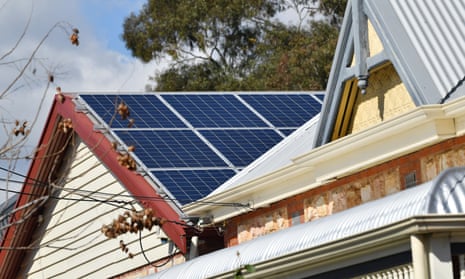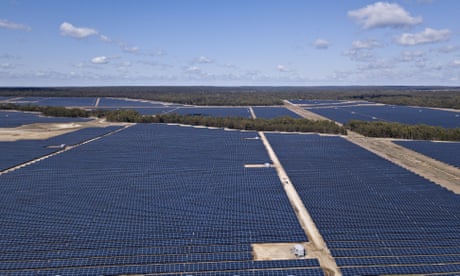Extract from The Guardian

China factory gate solar panel prices are 15% lower than last year, meaning a big saving on installations.
Clean Energy Finance calculates the price of systems will fall by 10% thanks to cheaper raw materials and more production in China and US.
Wed 14 Jun 2023 01.00 AEST
Last modified on Wed 14 Jun 2023 01.20 AESTThe Solar Pivot report by analysts Tim Buckley and Xuyang Dong said prices of polysilicon used to make the wafers in panels have fallen by two-thirds in 2023, sending panel prices down to US18c (A26.7c) per watt as of last month.
Global installations of solar hit a record 268 gigawatts last year and could reach 1000GW by 2030. “This would have profound implications for electricity and energy markets globally,” the report said.
“CEF foresees the world could hit 1000GW per annum of solar installs by 2030,” the report said. “This would have profound implications for electricity and energy markets globally.”
Panel maker JinkoSolar last month announced plans for a US7.9bn wafer-to-module solar factory in the Chinese province of Shanxi that alone will churn out as much as 56GW solar capacity a year. That scale is 19 times times the biggest US plant – now being built - and compares with Australia’s total solar capacity of 30GW as 2022.
“The energy sector for decades has failed to invest in technology,” Buckley said. “Now the Chinese are spending unbelievable amounts of money.”
The
US, the European Union and India are among economies also ramping up
investments in solar energy. The motivation is partly to decarbonise
their energy systems and reduce dependence on Russia but also to counter
China’s growing domination of renewable technologies, particularly
solar.
The Inflation Reduction Act passed by the US Biden administration, which set aside $US369bn to bolster energy security and manufacturing, will drive a five-fold increase in yearly panel output to 40GW by 2024 and double solar installs to 40-50GW a year to 2030.
By contrast, China is on track to have 12 solar manufacturing enterprises with annual module production capacity of 30GW each. It also will install 120-140GW of solar in 2023, doubling that to 260GW by 2030, the report said.
Buckley said catching up with China if energy security was the goal was “a serious problem”.
“They’re actually building market dominance with every year that goes by at the speed they’re moving,” he said, noting China’s share of global polysilicon output was already 75% in 2021 and will reach 90% by the end of this year.
With all that expanded production capacity, “it’s an easy guess to say module prices will drop 30 or 40% by the end of this year versus where they were at 12-18 months ago,” Buckley said.
Renate Egan, head of the
Australian Centre for Advanced Photovoltaics based at the University of
New South Wales, said the report was “comprehensive and optimistic”,
underscoring solar’s falling cost compared with energy sources,
including coal.
Egan said the findings were consistent with work being done by the Australian PV Institute for the federal government.
Other nations couldn’t replicate what China had done over two decades “in a few years”, but there were parts of the supply chain Australia could have competitive advantages, she said.
These include minerals processing such as converting sand to metallurgical grade silica. Similarly glass, aluminium and polymer components in modules could offer opportunities for Australia to focus on, Egan said.
“There’s huge room for improvement in deployment and connection costs” for modules, she added.
Finn
Peacock, founder of SolarQuotes, said China’s factory gate solar panels
were 15% cheaper this year. Given the slightly weaker Australian
dollar, “it seems reasonable that solar panel installers should soon see
around a 10% decline in panel prices compared to the end of last year”,
he said.
Wholesale prices for “a good mid-range panel” are about
$0.50/watt, excluding GST, from Australian warehouses. Countering much
of the decline, though, will be another 13% reduction in the solar rebate from next January.
At present, a 10kW rooftop system costs each household about $11,000. That price includes the rebate, now worth about $4400, which will fall to $3840 next year.
Online solar inquiries have spiked in the wake of the latest news of higher electricity prices with interest over the King’s Birthday weekend up 30% from a year earlier, Peacock said.

No comments:
Post a Comment